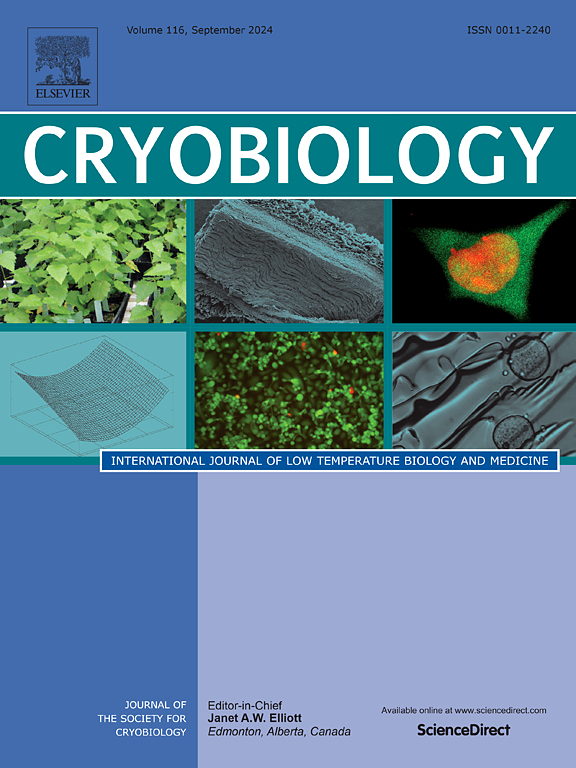Cryopreservation of Centropomus viridis gonadal tissue: A key step for conservation and aquaculture in Mexico
IF 2.1
3区 生物学
Q2 BIOLOGY
引用次数: 0
Abstract
The snook (Centropomus viridis) has a significant economic impact in Mexico's northern Pacific coastal region. Germ cell (GCs) cryopreservation is used as a strategy for species conservation due to its ability to transfer genetic information, promote self-renewal, and facilitate cellular differentiation, ensuring the propagation of the species. In this work, we present a protocol for the cryopreservation of gonadal tissue from juvenile snook (C. viridis). Gonadal tissue disaggregation was performed using trypsin (0.25 %, 0.30 %, 0.40 %, or 0.50 %). GCs were isolated using a Percoll density gradient (10 % and 40 %). Cryopreservation was performed using ethylene glycol and dimethyl sulfoxide (DMSO) at concentrations of 1.5 M or 2 M or the combination of 1.5 M DMSO, lactose (0.1 or 0.2 M), and 10 % egg yolk. Freezing was performed at −80 °C for 10, 15, or 30 min. GCs were identified using vasa by immunocytochemistry. Cell viability and concentration were assessed. Trypsin at 0.25 % resulted in a 98.25 ± 1.0 % cell viability. GCs were isolated from the 10 % Percoll band, with 36 % of the cells expressing vasa. Gonadal tissue cryopreserved with 2 M DMSO at −80 °C for 15 min exhibited the highest cell viability, with 71.83 ± 2.47 %. The results establish a baseline for guiding future cryopreservation efforts involving gonadal tissue from other marine fish species.
墨西哥绿鲳生殖组织的低温保存:保护和养殖的关键步骤
在墨西哥的北太平洋沿岸地区,斯努克(Centropomus viridis)具有重要的经济影响。生殖细胞(GCs)冷冻保存由于其能够传递遗传信息,促进自我更新,促进细胞分化,确保物种的繁殖而被用作物种保护的一种策略。在这项工作中,我们提出了一种低温保存幼鱼(C. viridis)性腺组织的方案。使用胰蛋白酶(0.25%,0.30%,0.40%或0.50%)进行性腺组织分解。采用Percoll密度梯度(10%和40%)分离gc。低温保存使用浓度为1.5 M或2m的乙二醇和二甲基亚砜(DMSO)或1.5 M DMSO、乳糖(0.1或0.2 M)和10%蛋黄的组合进行。在−80°C冷冻10、15或30分钟。免疫细胞化学用vasa鉴定gc。评估细胞活力和浓度。0.25%胰蛋白酶的细胞存活率为98.25±1.0%。从10% Percoll带中分离出GCs,其中36%的细胞表达vasa。用2 M DMSO在−80℃低温保存15 min的性腺组织细胞存活率最高,为71.83±2.47%。该结果为指导未来涉及其他海洋鱼类性腺组织的低温保存工作奠定了基础。
本文章由计算机程序翻译,如有差异,请以英文原文为准。
求助全文
约1分钟内获得全文
求助全文
来源期刊

Cryobiology
生物-生理学
CiteScore
5.40
自引率
7.40%
发文量
71
审稿时长
56 days
期刊介绍:
Cryobiology: International Journal of Low Temperature Biology and Medicine publishes research articles on all aspects of low temperature biology and medicine.
Research Areas include:
• Cryoprotective additives and their pharmacological actions
• Cryosurgery
• Freeze-drying
• Freezing
• Frost hardiness in plants
• Hibernation
• Hypothermia
• Medical applications of reduced temperature
• Perfusion of organs
• All pertinent methodologies
Cryobiology is the official journal of the Society for Cryobiology.
 求助内容:
求助内容: 应助结果提醒方式:
应助结果提醒方式:


